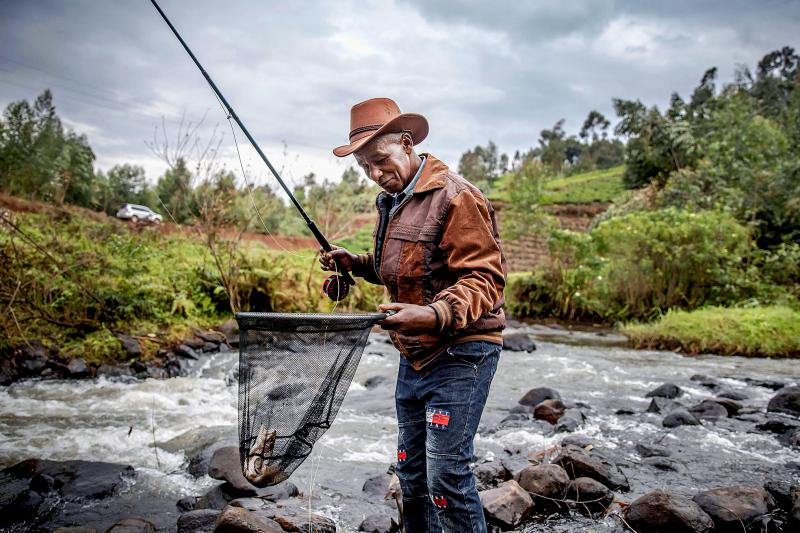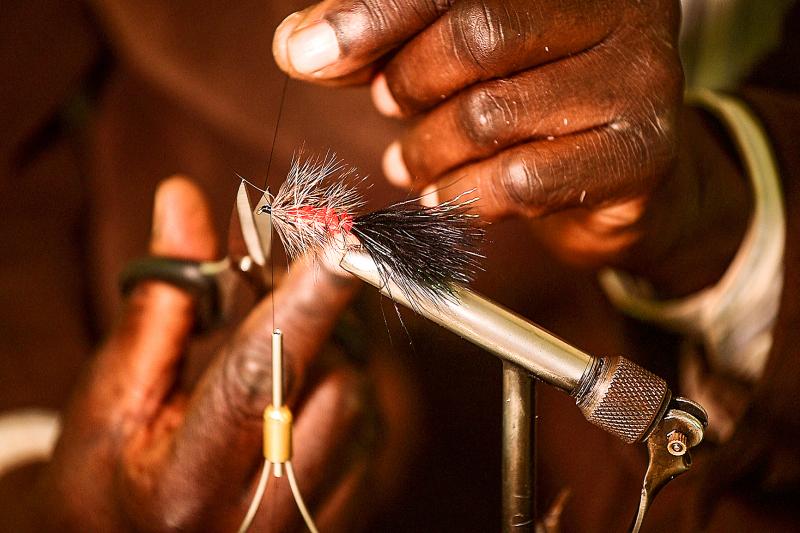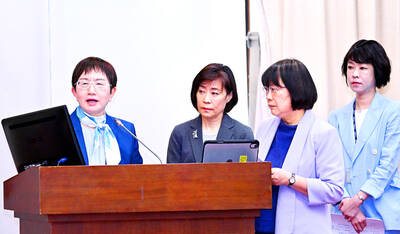With the nimbleness of a younger man, John Ngaii Moses skillfully knotted a tiny fishing fly onto his line and, hopping over mossy rocks, cast off into a surging river flowing through Kenyan tea country.
“I can tie a fly at night, without a light,” the 60-year-old fisherman said with a grin, flicking his line with a graceful arc into the pristine waters.
Moses is something of a rarity in Kenya, where fishing for recreation is neither popular nor widely understood, and even viewed warily as a vestige of colonial times.

Photo: AFP
Yet the country occupies a special place in the world of fly fishing, and enthusiasts believe demystifying the sport could create jobs and encourage future generations to protect rivers.
Kenya boasts one of Africa’s oldest fishing clubs, and a fly tying industry that for decades has supplied fishers from Norway to New Zealand with hand-crafted lures.
Visitors come from all over the world to fish in its highland rivers and alpine lakes, where the British introduced trout in the early 1900s.

Photo: AFP
Fish do not draw tourists like the big cats on Kenya’s savannas, but what is on offer for the intrepid fisher is no less remarkable.
Just two hours’ drive from Nairobi, where the Mathioya River crashes beneath the Aberdare Range, prime fishing country meets wilderness inhabited by black rhinos and elephants.
“Imagine spending the morning ... fishing and the afternoon out taking pictures of wild animals. Where else can you have this?” said Zac Gichane, owner of Aberdare Cottages and Fishing Lodge, a resort overlooking the Mathioya.
He said fly fishing was a multibillion-dollar global industry ripe for expansion in Kenya.
“It is God’s country. Two hours from Nairobi and you find crystal-clear rivers, a peaceful village, greenery... The opportunities here are limitless,” Gichane said.
Gichane sources his fishing flies from Kenyan crafters whose delicate and elaborate creations have become a mainstay for anglers worldwide.
These artificial lures — some so small they perch on a fingertip — are designed to imitate the particular insects that trout, salmon and other species feast on.
Moses prefers the “royal coachman” — traditionally dressed with feathers and a tail — because it resembles a butterfly native to the Mathioya that brings trout to the surface.
Reliable data is scant, but some estimates suggest one in three flies used in Europe originate in Kenya, while millions more are shipped to the US, Canada and other key fishing markets.
“It is a big business in Kenya. It employs a lot of people,” said John Nyapola, who owns Ojoo Fishing Flies Designers.
In his small workshop outside Nairobi, flamingo feathers, rabbit pelts and all manner of furs and fabrics litter an assembly table where custom orders from Canada, Australia and Japan are individually hand-tied.
“We have made them all,” said Jane Auma, a veteran fly tier with 32 years of experience, pointing to a well-worn catalog detailing 1,000 individual lure designs.
Their names — such as “Woolly Bugger,” “Copper John” and “Irresistible Adams” — are as baffling to most tiers as the sport itself.
“We do fish, but we don’t use flies. We use nets, and we try and catch everything,” Auma said, laughing.
Fly fishers, by contrast, mostly return whatever they catch to the river, to prevent overfishing.
Gichane said the catch-and-release ethos is considered “madness” by Kenyans who fish for food.
Some also dismiss the sport as a strange import.
Decades ago, the Mathioya valley was a hotbed of anti-colonial resistance, and suffered British reprisals.
Gichane said that before independence in 1963 — and even for a time after — many Kenyans would not dare pick up a rod.
“They think sport fishing is for mzungus [white people], not for Africans,” said Moses, who was born in a British internment camp, and is today a fishing guide.
The Kenya Fly Fishers’ Club, a private 102-year-old establishment on the Mathioya, has sought to broaden the sport’s appeal.
The club has welcomed more Kenyan members as interest has grown, and elected its first black chairman in 2018.
“Times are changing — same as fly fishing. Right now we have a lot of local, indigenous Kenyans who are fishing. I am one of them,” said Musa Ibrahim, a trustee and 20-year member of the club.
It has also reached out to local schools, to introduce children to fly fishing and its conservation aspects such as replenishing the Mathioya with trout.
Kenya at its prime was criss-crossed by 2,000km of unspoiled trout-fishing rivers, but rapid land conversion reduced that 10-fold, Ibrahim said.
“It’s up to us to make sure that we leave the legacy for the next generation,” he said.

‘SWASTICAR’: Tesla CEO Elon Musk’s close association with Donald Trump has prompted opponents to brand him a ‘Nazi’ and resulted in a dramatic drop in sales Demonstrators descended on Tesla Inc dealerships across the US, and in Europe and Canada on Saturday to protest company chief Elon Musk, who has amassed extraordinary power as a top adviser to US President Donald Trump. Waving signs with messages such as “Musk is stealing our money” and “Reclaim our country,” the protests largely took place peacefully following fiery episodes of vandalism on Tesla vehicles, dealerships and other facilities in recent weeks that US officials have denounced as terrorism. Hundreds rallied on Saturday outside the Tesla dealership in Manhattan. Some blasted Musk, the world’s richest man, while others demanded the shuttering of his

TIGHT-LIPPED: UMC said it had no merger plans at the moment, after Nikkei Asia reported that the firm and GlobalFoundries were considering restarting merger talks United Microelectronics Corp (UMC, 聯電), the world’s No. 4 contract chipmaker, yesterday launched a new US$5 billion 12-inch chip factory in Singapore as part of its latest effort to diversify its manufacturing footprint amid growing geopolitical risks. The new factory, adjacent to UMC’s existing Singapore fab in the Pasir Res Wafer Fab Park, is scheduled to enter volume production next year, utilizing mature 22-nanometer and 28-nanometer process technologies, UMC said in a statement. The company plans to invest US$5 billion during the first phase of the new fab, which would have an installed capacity of 30,000 12-inch wafers per month, it said. The

Taiwan’s official purchasing managers’ index (PMI) last month rose 0.2 percentage points to 54.2, in a second consecutive month of expansion, thanks to front-loading demand intended to avoid potential US tariff hikes, the Chung-Hua Institution for Economic Research (CIER, 中華經濟研究院) said yesterday. While short-term demand appeared robust, uncertainties rose due to US President Donald Trump’s unpredictable trade policy, CIER president Lien Hsien-ming (連賢明) told a news conference in Taipei. Taiwan’s economy this year would be characterized by high-level fluctuations and the volatility would be wilder than most expect, Lien said Demand for electronics, particularly semiconductors, continues to benefit from US technology giants’ effort

Minister of Finance Chuang Tsui-yun (莊翠雲) yesterday told lawmakers that she “would not speculate,” but a “response plan” has been prepared in case Taiwan is targeted by US President Donald Trump’s reciprocal tariffs, which are to be announced on Wednesday next week. The Trump administration, including US Secretary of the Treasury Scott Bessent, has said that much of the proposed reciprocal tariffs would focus on the 15 countries that have the highest trade surpluses with the US. Bessent has referred to those countries as the “dirty 15,” but has not named them. Last year, Taiwan’s US$73.9 billion trade surplus with the US